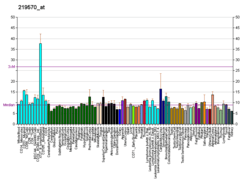KIF16B
Kinesin family member 16B, also known as KIF16B, is a protein which in humans is encoded by the KIF16B gene.[5]
See also
References
Further reading
- Seet LF, Hong W (2006). "The Phox (PX) domain proteins and membrane traffic". Biochim. Biophys. Acta. 1761 (8): 878–96. doi:10.1016/j.bbalip.2006.04.011. PMID 16782399.
- Miki H, Okada Y, Hirokawa N (2005). "Analysis of the kinesin superfamily: insights into structure and function". Trends Cell Biol. 15 (9): 467–76. doi:10.1016/j.tcb.2005.07.006. PMID 16084724.
- Worby CA, Dixon JE (2003). "Sorting out the cellular functions of sorting nexins". Nat. Rev. Mol. Cell Biol. 3 (12): 919–31. doi:10.1038/nrm974. PMID 12461558.
- Vasilescu J, Zweitzig DR, Denis NJ, et al. (2007). "The proteomic reactor facilitates the analysis of affinity-purified proteins by mass spectrometry: application for identifying ubiquitinated proteins in human cells". J. Proteome Res. 6 (1): 298–305. doi:10.1021/pr060438j. PMID 17203973.
- Hoepfner S, Severin F, Cabezas A, et al. (2005). "Modulation of receptor recycling and degradation by the endosomal kinesin KIF16B". Cell. 121 (3): 437–50. doi:10.1016/j.cell.2005.02.017. PMID 15882625.
- Gerhard DS, Wagner L, Feingold EA, et al. (2004). "The status, quality, and expansion of the NIH full-length cDNA project: the Mammalian Gene Collection (MGC)". Genome Res. 14 (10B): 2121–7. doi:10.1101/gr.2596504. PMC 528928. PMID 15489334.
- Ota T, Suzuki Y, Nishikawa T, et al. (2004). "Complete sequencing and characterization of 21,243 full-length human cDNAs". Nat. Genet. 36 (1): 40–5. doi:10.1038/ng1285. PMID 14702039.
- Strausberg RL, Feingold EA, Grouse LH, et al. (2003). "Generation and initial analysis of more than 15,000 full-length human and mouse cDNA sequences". Proc. Natl. Acad. Sci. U.S.A. 99 (26): 16899–903. doi:10.1073/pnas.242603899. PMC 139241. PMID 12477932.
- Deloukas P, Matthews LH, Ashurst J, et al. (2002). "The DNA sequence and comparative analysis of human chromosome 20". Nature. 414 (6866): 865–71. doi:10.1038/414865a. PMID 11780052.
- Nagase T, Kikuno R, Nakayama M, et al. (2001). "Prediction of the coding sequences of unidentified human genes. XVIII. The complete sequences of 100 new cDNA clones from brain which code for large proteins in vitro". DNA Res. 7 (4): 273–81. doi:10.1093/dnares/7.4.271. PMID 10997877.
This article is issued from
Wikipedia.
The text is licensed under Creative Commons - Attribution - Sharealike.
Additional terms may apply for the media files.





